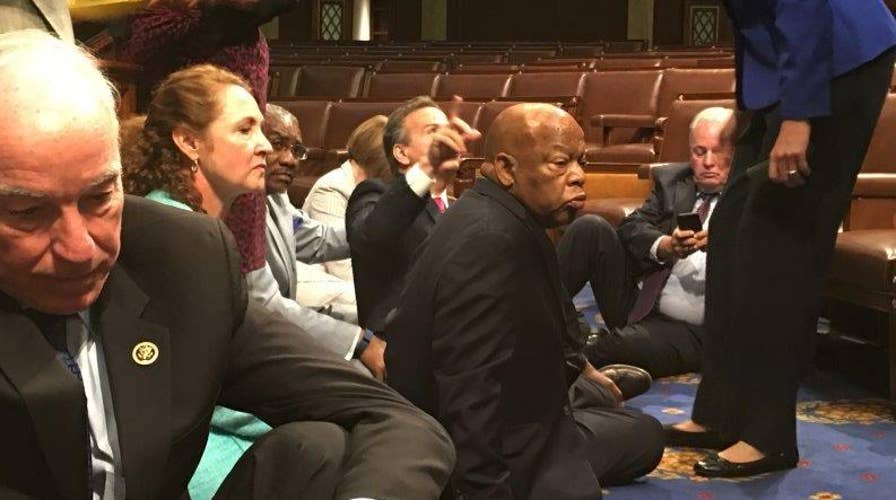The House of Representatives returns to legislative session Tuesday after a nearly two-week respite. Democrats are again planning a donnybrook over guns.
The House first meets at noon for short speeches and then 2 p.m. for legislative business. No votes are planned until 6:30 p.m. But some Democrats plan to pick up with the firearms fight precisely where they left off in late June with an unprecedented sit-in on the House floor.
Over the weekend, Fox News obtained a memo sent from the leadership of the Congressional Black Caucus (CBC).
“Rep. Robin Kelly (D-IL) would like CBC members to be present for Floor activities on gun violence when the House returns to session on Tuesday, July 5, 2016,” read the missive. “The plan is to be as disruptive to (House) Speaker (Paul) Ryan (R-WI) as possible next week.”
Ryan insists he won’t “tolerate” more disruption. Ryan, his staff, other House GOP leaders, along with representatives from the House Sergeant at Arms Office and the Office of the Parliamentarian have discussed ways to quash additional dustups.
According to the CBC dispatch, initial Democratic efforts Tuesday may comport with traditional House forms of protest. The CBC wants a parade of its members to deliver five-minute speeches on guns when the House meets at noon. They’ll follow that up with a procession of one-minute speeches when the House gavels back in at 2 pm. Then, during unrelated evening votes, the CBC asks members to hold “a printed piece of paper with an image of a constituent killed by a firearm.” Once the House completes the votes, Democrats plan to give more gun speeches throughout the evening.
It’s unclear if Democrats would deploy additional floor tactics later in the week. Democrats think they hold the advantage on the issue. The CBC email notes “the focus of the day is not just mass shootings and terrorism, but the everyday killings that are occurring in many CBC Member districts.”
The most important event of the day is a 5 pm et meeting of the House Rules Committee. The Rules Committee serves as the gateway to the House floor for legislation. The Rules panel will prepare a bill to address radicalization and curb suspected terrorists from obtaining guns.
In late June, the Senate failed to sideline a bipartisan plan drafted by Sen. Susan Collins (R-ME) to grant the Attorney General power to halt gun sales to persons on the no-fly list. But ironically, the survival of Collins’ amendment seemingly doomed the plan. After Collins’ amendment survived a test vote, the Senate never held an up/down vote on the amendment itself. The Senate then stopped consideration on the underlying bill.
Incorporated into the House bill is a provision the Senate did kill off, written by Senate Majority Whip John Cornyn (R-TX). This effort grants the Attorney General three days to impede weapon transfers while police investigate.
Democrats say they’ll stand down in their gun protests if Republicans permit a vote on “no-fly, no buy” and an effort to expand background checks. But the GOP-authored measure doesn’t impress Democrats.
“House Republicans are once again putting the NRA ahead of their responsibility to keep the American people safe,” said House Minority Leader Nancy Pelosi (D-CA). “This bill is just the latest evidence that House Republicans have become a wholly-owned subsidiary of the NRA.”
The Rules Committee governs how much time the House will allocate to a given issue and if the House will consider any amendments. Democrats naturally want the Rules Committee to permit votes on the “no fly, no buy” and background check amendments. The CBC’s calling on its members to attend the Rules panel meeting and push for a vote on those plans.
A political cunning looms behind the Democratic gambit. Certainly Democrats want the House to adopt those amendments and get them signed into law. But what Democrats are simultaneously doing is trying to engineer roll call votes on those issues and either force Republicans to vote yes – or vote no and face political consequences.
Republicans are no dummies. They know what Democrats would do if the GOP allowed votes on those amendments and Republicans voted nay. Democrats would immediately empanel political allies and the Democratic Congressional Campaign Committee (known as the DCCC, the national organization devoted to electing Democrats to the House) to document how endangered Republicans cast their ballots. Democrats would then run ads and generate a public outcry against Republicans who voted no.
Democrats wouldn’t only target Republicans who face competitive races this fall. They’d try to put a few other seats in play, too. The current breakdown in the House of Representatives is 247 Republicans to 187 Democrats with one vacancy. Democrats need to flip 30 seats to reclaim control of the House. They sense trouble on the GOP side with Donald Trump topping the Republican ticket. The best thing House Democrats have going this cycle is volatility in the electorate. But few political analysts give Democrats little more than an outside shot at winning back the House this fall.
This is why Republicans may move to lock down this debate and not permit the House to consider the Democrats’ amendments.
Sure, Democrats can then take the GOP refusal to consider firearms proposals to the voters. Democrats argue they have some traction on the gun issue compared to the aftermaths of other mass shootings. But is this newfound traction enough to make a difference at the ballot box? Democrats haven’t translated the gun issue into additional House and Senate seats in years. Voters sent former Rep. Carolyn McCarthy (D-NY) to Congress in 1996 on a gun control platform. A gunman murdered McCarthy’s husband and seriously wounded her son during a 1993 mass shooting on the Long Island Rail Road.





